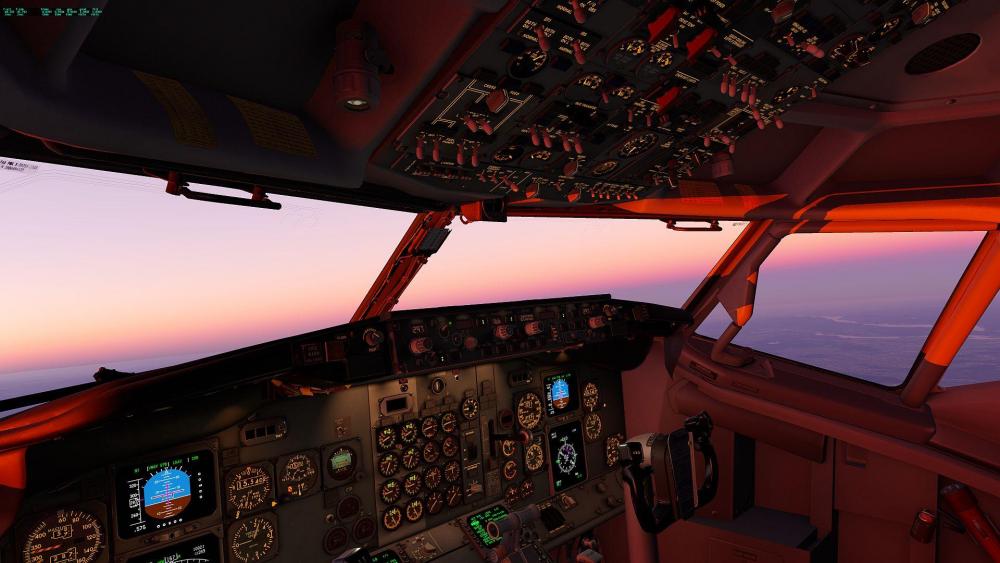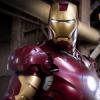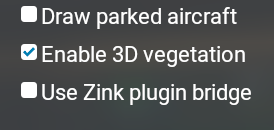Leaderboard
Popular Content
Showing content with the highest reputation on 06/04/2023 in all areas
-
4 points
-
This might be the loudest sound in the whole airplane package. Is that intentional? lol it's SO loud I assumed it was a fuel pump or something.2 points
-
Version 1.0.0
311 downloads
Hotstart Challenger 650 | RedBull Racing (Fictional) | OE-BUL Tested for X-Plane 12 only. Normals may look weird on 11!!! Enhanced texturing including - New cockpit windshield - Improved aircraft fuselage normals - Improved riveting - Improved engine exhaust and intake - Tuned glossiness - Tuned cabin windows Please respect my work. Copying/Modification is not permitted. Happy flying!1 point -
1 point
-
1 point
-
its definitnely loud. The motor sits right under the cockpit floor practically and turns the floor into a bit of an soundboard style amplifier. About 18 secs in, you can hear that oscillating motor sound. -tk1 point
-
Version 1.1
200 downloads
Livery for N89 (very similar to N88, N90, etc), flown by the FAA on Flight Check missions to ensure procedures, airways, and more can be flown and relied on safely. Many thanks to a real Flight Check captain for providing direct color references. To my eye the registration looks best in Arial Bold. For copyright reasons, this font file is not included in the download - if you're running Windows, you should be able to grab it out of your C:\Windows\Fonts folder and copy it in to the livery folder. If not, there are several open alternatives to Arial that will probably look fine.1 point -
1 point
-
1 point
-
Every operation will be somewhat different of course.... Once we complete the last leg of the day and the shutdown check is complete, one of us is immediately getting up out of the seat to open the cabin door and go verify chocks are in place, the nose doors are opened, and 5 pins are inserted. Of course if our last leg is a passenger leg - they are disembarked first. One pilot typically stays with them for the walk to the vehicles or the FBO - while the other pilot heads to the interior of the baggage compartment to pass the bags to line crew. That pilot then comes through the cabin to check for forgotten personal items - concluding with a thumbs up to the pilot adjacent the vehicles. If they walked inside - typically a text is sent between pilots that the cabin is clear (or isn't). At this point the pilot with the airplane will coordinate with the line crew re: required services - verifying chocks are in place - then retrieving the pins and inserting them. Different operations have different philosophies/standards regarding nose doors opened or closed. At our home base - we will always open the doors and insert 5 pins. Away from home while on the road we can exercise discretion to leave them closed. In a location with security concerns, or if there are any concerns regarding tugs, line crew, etc - we may elect to go with 3 pins and leave the doors closed. I'd say in our operation the doors are left open with 5 pins the majority of the time. Under no circumstance will we leave the nose doors open without inserting the 2 additional pins. Once pins are inserted and we're both back on the jet - it's time to start cleaning up and preparing for the next flight. Garbage is gathered, old coffee is dumped, drinks in the drawer with paper labels are removed from the ice bins - leftover catering is emptied from the chiller and either given to line crew as trash, as a gift, or to be stored in the FBO fridge. If the cabin needs to be vacuumed - we vacuum while power is still on. Tables and surfaces are cleaned at this point, seatbelts are cleaned and put back into presentation , the sinks and lav are cleaned and while this is happening - line crew is probably performing the lav service. Dishes and linens are given to line service as well. We like to keep power on until all of that is finished so we can check the lav - that enough (hopefully clean) water has been put back in and its back to smelling/looking fresh. We also have to restock from the storage drawers in back. Things like snacks, drinks, chips etc - all have to be replenished. If 15 minutes has gone by - one pilot is checking/servicing the oils in the utility bay. If temps will dip towards or below freezing - we purge the potable water system. This is often done at TOD depending on circumstances to avoid dumping 10 gallons of potable water on an FBO ramp which will turn into an iceberg. Water lines must be purged on the ground which is similar to prepping a recreational vehicle or boat for winter storage , minus the antifreeze, although there's different techniques there too. Sometimes during all of this we may also fuel for the next day's flight - circumstances of course dictate when we would do this as there are considerations to keep in mind leaving the jet with a lot of fuel. We also will consolidate crew baggage and put it in the baggage door opening in preps for offloading. We ensure the garbage, catering, fridge items, etc - are indeed all off. The parking brake at this point has probably long been released since chocks were verified - and the signs put in the cockpit windows indicating the jet is safe to tow. We verify one of us has recorded the 'numbers' from the FMS for the trip paperwork. (OFF/ON/FLIGHT times and OUT/IN Fuel) Suction cupped iPad mounts are removed from the windows, the Sentry is verified as off and packed up so it can be charged at the hotel if needed. If it was a night flight and next flight is day, and we're about to secure the airplane - lights will be brought back to a daytime config (full bright). If it's a hot and sunny location - cabin window shades are closed and cockpit reflective covers are put in place. We also have a pin to secure the emergency exit in the cabin that gets inserted. At this point we verify requested services have been received/completed and we check with the other crewmember or crewmembers that they are done with cabin power. From here one of us typically runs the securing checklist and shuts down the APU. But we aren't done yet. Our bags get unloaded at this point and we build our 'pile'. All external panels are locked. A thorough post flight walk-around is completed, typically by both of us. Covers are put on all 3 pitots, both ice detectors, the AOA cone and both AOA vanes. Both batteries are disconnected. Whichever pilot didn't do the cockpit securing - must 'check switches' to make sure all is where it should be. Now it is finally time to make sure everyone is 'done inside' and the door gets closed/locked - and now - we can walk into the FBO, or to our rental car which has been brought planeside. We check in at the CSR desk regardless - providing contact info, verifying the schedule and services requested. This is a great time to make sure we go over the 'stuff in the fridge, the lav service, hangar arrangements, etc etc'. Only after this is all done do we leave the airport and head to the hotel where the trip PIC does 'the paperwork' which in our operation is electronic and must be submitted in a reasonable amount of time after the flight. At home base our operation has a cleaning service that will take care of many of the above tasks, and since another leg often isn't happening the next day - we're off the airplane pretty quickly. Hope this helps understand some of the things that go into this side of the business. On an international arrival after a long day mid-trip- it wouldn't be uncommon for the crew to take 30-45 minutes to do all of the above correctly.1 point
-
1 point
-
It’s not a manual, but I’ve addressed the fuelling stuff and basic FBO interaction in my first video, which shows the initial procedures, up to the point you’d transfer to the simulated FO. 25 minutes or so that should help any new 650 driver get started, further videos will follow too.1 point
-
“That's understandable. If the product doesn't suit the kind of simulation you are interested in then it's great there are other addons that suit your needs better. Simulation isn't a game of "collect them all" - some products fit some people, others don't, and it's great to have variety. Regarding the failure system, some of the testers and consultants have been working on training scenarios, including handling notes and extracts from the abnormal procedures for the aircraft. The intention is to develop this over the life of the product to use the failure system to train sim pilots on Challenger 650 operation, just like real life pilots are trained at recurrent simulator visits“ …Graeme_77….I’ve probably failed to express myself correctly. Please accept my apologies for that. The fact that you had “testers and consultants “ that helped HOT START develop this add on “by the book” it is simply no doubt!….Anyway look at “BlackBird_GR “ answer. That is what I ( tried..) to get. I only asked some ( legal..) way to give us customers a way to put our hands on some sort of FCOM/Manuals/QRH. I’m an Airline Pilot and I don’t care flying a single engine approach or dealing with loss of Hydraulic system simply “guessing “ or trying to “figure out” the solution. The only approach I have to the so called “abnormal/emergency scenarios “ is through the study-interpretation of the books/manuals. And I don’t care if such books are current or experied. I simply need something to rely on when dealing with an Emergency…..anyway BlackBird_GR has already answers and sorted out the whole tread.So it is no point discuss this thread any further. Anyway please understand that I allow myself to criticize you only because I know you’re the best decelopers for XPlane so far. Rest assured thanks for this amazing add on please keep updating this amazing aircraft:-)1 point
-
That's understandable. If the product doesn't suit the kind of simulation you are interested in then it's great there are other addons that suit your needs better. Simulation isn't a game of "collect them all" - some products fit some people, others don't, and it's great to have variety. Regarding the failure system, some of the testers and consultants have been working on training scenarios, including handling notes and extracts from the abnormal procedures for the aircraft. The intention is to develop this over the life of the product to use the failure system to train sim pilots on Challenger 650 operation, just like real life pilots are trained at recurrent simulator visits.1 point
-
https://www.smartcockpit.com/plane/BOMBARDIER/CHALLENGER 605.html A source for some stuff Best Steff1 point
-
Could a go-around procedure and anti-ice procedures (when to use cowl and engine anti-ice) be added to normal checklists?1 point













